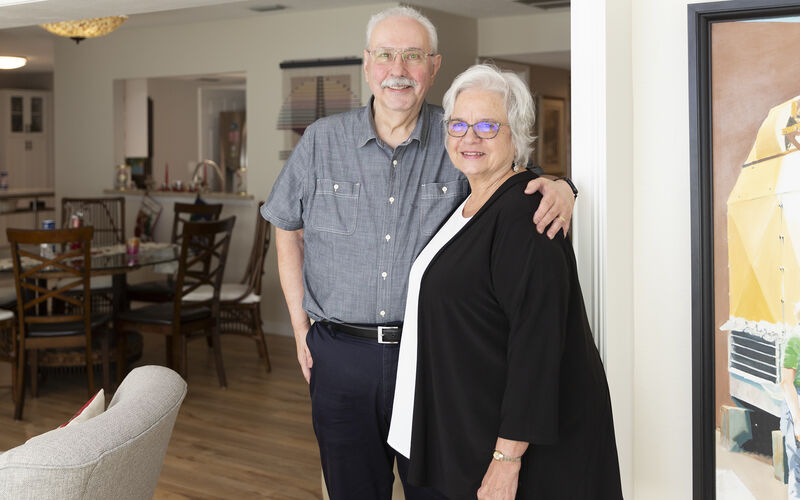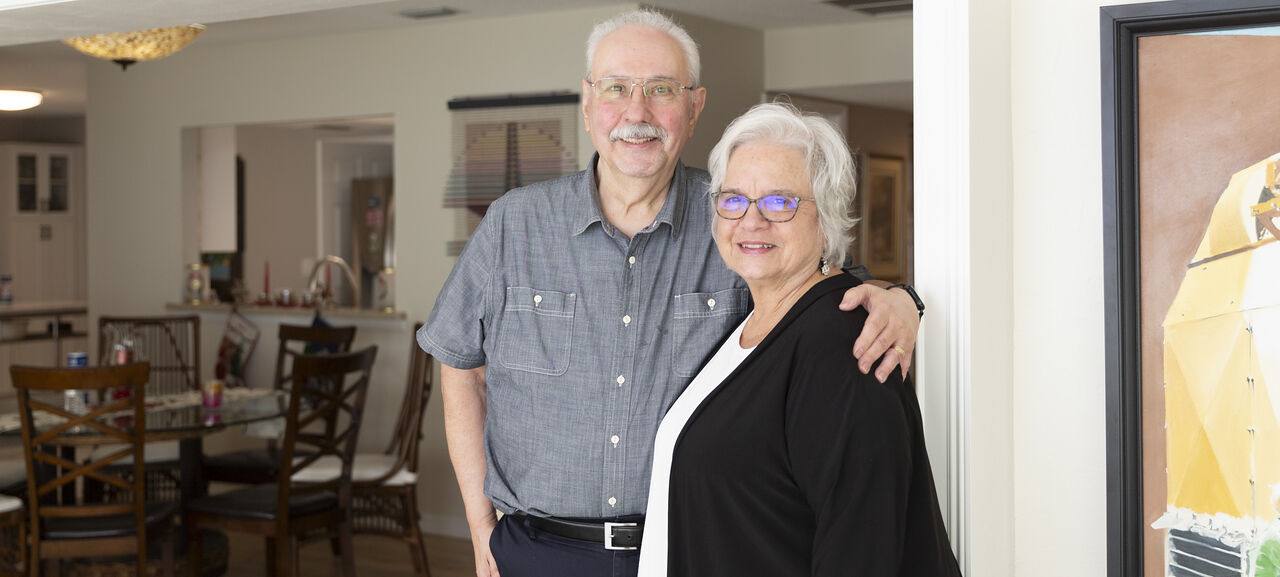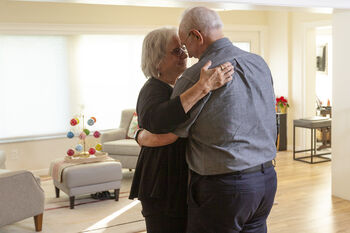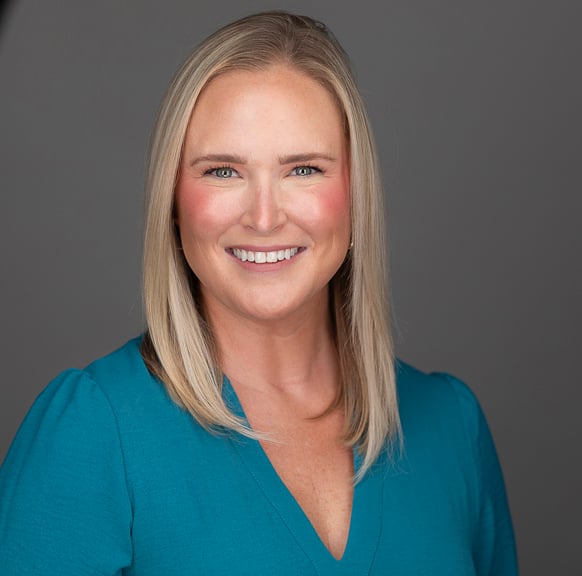Reaching for the Stars
On moonless nights, Bob Snedeker carries out his planetary telescope through the back door of his Bradenton home. The backyard setup is tedious with nearly 40 pounds of equipment, but the labor of love is worth the images he is about to capture. As each tripod leg is tightened and the mount with a digital camera is locked, Bob controls the scope from his phone as it calibrates.
He peers through the viewfinder, tracking faint glimmers of galaxies light-years away. With each careful adjustment, he marvels at the vast expanse above — a universe of endless questions and unknown answers. The shutter of the camera clicks, freezing that moment in time.
“My most distant object is 12 million light-years away. So you’re photographing light that was emitted 12 million years ago and has traveled that distance to Earth,” Bob said. “It’s just fascinating to me. It’s like a time machine. It’s your chance to look into the past.”
The telescope was a gift from his wife of 48 years, Karen. Framed photos of what it captures cover walls in their home. This pastime is not only fun but also therapeutic as Bob sets up and takes down the scope each night. It reminds him that space is a place of wonder but also uncertainty with no roadmap, no guarantees, only the courage to keep looking.

Bob knew a chimeric antigen receptor T-cell therapy clinical trial might be his last chance. “When you’re told, ‘This is the shot that you have,’ you take it,” he said.
It is the same courage Bob relied on when his focus shifted from exploring life through photography to confronting a more personal challenge. He was venturing into the equally unfamiliar territory of cancer.
“It makes you think about your place in the universe,” Bob said. “There is a parallel between where we are in our little Milky Way galaxy compared to the universe. There’s a parallel to what a cancer sufferer is going through against the overwhelming odds of being able to pull through it.”
From Dancing to a Diagnosis
Bob and Karen met on lunch duty in the Alliance High School cafeteria in Alliance, Ohio. He was a social studies teacher, and she taught English. They married in 1977 and took on a new hobby together: ballroom dancing.
“If you’re ballroom dancing, you’re in each other’s arms for the evening,” Bob said. “If you have any issues, if you have any problems, you better work it out. It is a great hobby that we really enjoy.”
After two successful careers, they moved to Bradenton in 2009 to enjoy retirement, be closer to Karen’s parents and live near the beach.
For their 40th wedding anniversary in 2017, Bob and Karen planned a trip across Canada, filling their days with exploring and hiking. However, Bob began to feel a nagging pain in his leg that slowed him down. Initially, he thought it was a flare-up of his sciatica, but the idea of walking with a limp at 68 years old didn’t sit well with him. Determined to find the root of the issue, he decided to investigate further when they returned home.
Initial scans came back with a request for another round. The second scan revealed a mass and, eventually, a diagnosis of stage 4 diffuse large B-cell lymphoma, a form of non-Hodgkin lymphoma. The cancer had spread beyond the lymphatic system and was present in other organs throughout his body.
“The oncologist [in Sarasota] had to deliver the message: Go home and put your affairs in order,” Bob said. “That was a tough weekend. We kept that news to ourselves and took the weekend to discuss what we might do and what the future would look like.”
Bob admits he had led a fortunate life — at 68, he had never broken a bone or been hospitalized for any health issues. So the Snedekers were shocked by the diagnosis. Meanwhile, Karen’s late sister, Phyllis, was also battling cancer and became the couple’s guiding support throughout their journey.
“He has always just been so healthy and a strong guy. We had no clue,” Karen said. “Phyllis was kind of our coach, and the message from her and her husband was to find a doctor you trust, a doctor you like, and listen to them.”
Julio Chavez, MD, offered Bob the chance to participate in a CAR T study, which eventually led to an FDA approval.
Bob sought treatment at Moffitt Cancer Center, where Julio Chavez, MD, a hematologist in the Malignant Hematology Department, guided his care. Bob responded well to chemotherapy, and his cancer went into remission in June 2018. The couple were thrilled and celebrated the milestone, but in the back of Bob’s mind, he couldn’t shake the fear that the cancer might return.
“I think when you have cancer, you say to yourself, there’s treatment, but there is no cure. You talk about remission, partial remission and even complete remission, but you really can’t talk about the cure,” Bob said.
Four months later, his fear became a reality. Scans showed Bob’s cancer returned with a vengeance. He had tumors in 13 places in his body, resulting in yet another stage 4 diagnosis.
The couple returned to Moffitt to hear their options.
“It was a get-your-affairs-in-order kind of time, round two, prepare to do what you need to do to face the end of life. We were, of course, able to do that,” Bob said. “I was very fortunate to have Karen and someone with whom I didn’t have to carry the burden alone.”
One Last Shot
B-cell lymphoma affects the lymphatic system, a network of lymph nodes, vessels, organs and tissues that maintains the body’s fluid levels and helps fight off infection. It occurs when lymphocytes multiply uncontrollably.
“We can cure about 50% to 60% of patients with initial treatment,” Chavez said. “However, a good portion of patients will relapse and will become refractory, and sometimes it’s a challenge to treat those patients.”
When the Snedekers returned to Moffitt after Bob’s relapse, they were welcomed with an opportunity to participate in a clinical trial for a process called chimeric antigen receptor T-cell therapy, or CAR T. This type of immunotherapy uses the body’s immune cells, transforming them into cancer-fighting agents designed to seek out and destroy cancer cells.
Initially, CAR T therapy was approved in 2017 by the Food and Drug Administration for patients who had exhausted other lines of conventional treatment. This study was designed to challenge the existing treatment paradigm and shift CAR T therapy from a last resort to a second-line treatment.
“That patient has to really trust in the science, the institution and their care team to offer his body to do this treatment. I can’t imagine how difficult that is for a patient,” Chavez said.
Bob underwent evaluation for the study and met all the necessary criteria. Out of 19 spots available at Moffitt, he was chosen for the final one. With no promise of success, Bob knew this was his best and possibly last chance.
“When you’re told, ‘This is the shot that you have,’ you take it,” Bob said. “It might be a full court, under heavily guarded conditions and you’re just flinging the ball up. But if the clock is hitting zero, you’re down by two points, and you get the ball in your hands, you shoot it.”
A Lifesaving Drive
Bob began the process right away, but after apheresis — the collection of his T cells — his health took a turn. He was home but unable to walk, talk or get out of bed. It was a Sunday evening, and Karen knew she needed help. She called the Moffitt emergency line, and within 10 minutes, she was advised to pack a bag and get Bob to the cancer center as soon as possible.
“I think both of us were afraid he was going to die in the car and on the way up. That was the scariest moment,” Karen recalled.
What was the most challenging and longest drive of her life may have saved Bob. When they arrived, care teams were waiting to take over. That evening started Bob and Karen’s seven-week stay at Moffitt.
“When we got to Moffitt, it was still terribly frightening, but the people who could save him were there,” Karen said. “I felt that if I had hesitated to make that phone call or if the person on the other end had not gotten back to me so quickly, I don’t think he ever would’ve lived to get his cells.”
The whiteboard in Bob’s room displayed a countdown of days until his new genetically modified T cells arrived at Moffitt. Once they did, he was quickly prepped for the infusion. Bob remembers receiving the cells, but in the days that followed, severe neurological side effects set in. As he experienced hallucinations, the medical staff supported him through the challenges, guiding him with exercises to evaluate his mental and motor skills.
Eventually, Bob was transferred to a rehabilitation hospital in Sarasota. Months of discipline, hard work and physical therapy transformed him — from lying on a gurney to sitting in a wheelchair, then walking with an aid, to finally dancing once again with the love of his life.
“When we get a chance to dance on the beach or dance in our living room to a song that we like, and I’m holding Karen in my arms, and we’re laughing and moving around the floor clumsily, it’s a feeling of, ‘Yeah, we’re back. This is life, and we’re enjoying it,’” Bob said.
From Survival to Impact
Bob has been cancer free for nearly six years. His monthly scan gradually shifted from every three months to once a year. He credits the clinical trial, groundbreaking science, Karen and the team at Moffitt for saving his life.
Bob and Karen don't miss any chances to dance and enjoy their life together. He is now six years cancer free.
In turn, Bob is now helping save the lives of others through his participation in the trial. The study led to FDA approval for CAR T therapy as a second-line treatment in 2021. Chavez was thrilled to share the news with Bob.
“He was emotional when he found out that he contributed” to the approval, Chavez said. “I always tell patients the outcomes of the trial, so they can tell the story, too, and understand that they did something for the future, for science and other patients.”
Moffitt was the first treatment center in the world to have treated over 1,000 patients with CAR T therapy. Researchers are continuing to develop the next generation of CAR T treatments to tap into the body’s immune system more effectively.
“We are treating more patients every year,” Chavez said. “I think the next step for me will be access. I think the access [for other countries] will be important. I’m looking to expand globally in the future.”
Thanks to CAR T therapy, Bob and Karen are embracing life, whether it is spending time with family, stargazing or dancing a nearly perfect rumba to the sounds of the waves crashing on the beach. Together, they are cherishing every moment.
“If you’ve been through something like this as a couple, you come out different as a couple, too,” Karen said. “You’re closer, stronger. You have a different focus on what’s important. So the things that are in our life are very, very meaningful.”
This article originally appeared in Moffitt's Momentum magazine.






